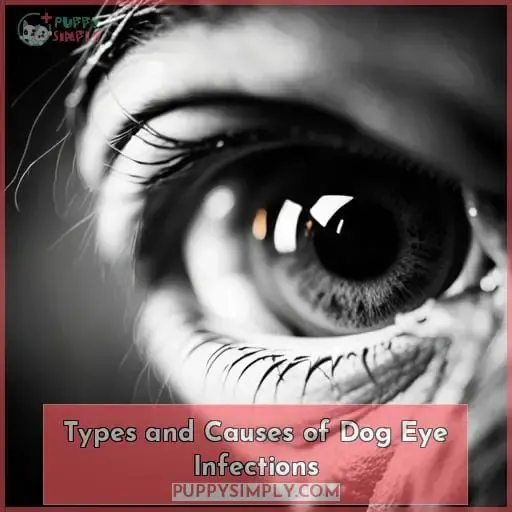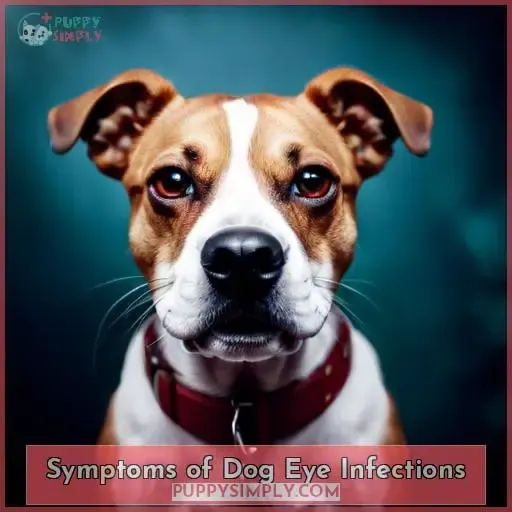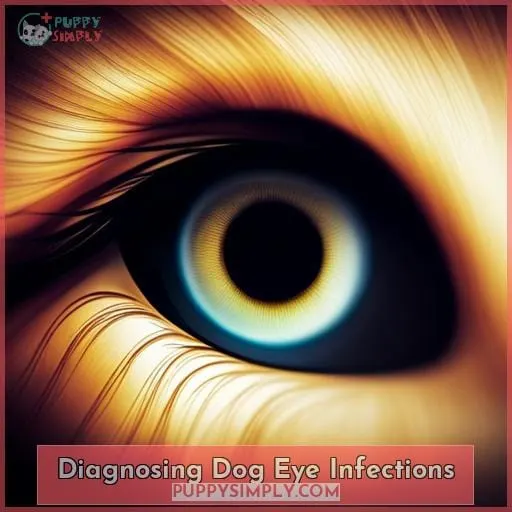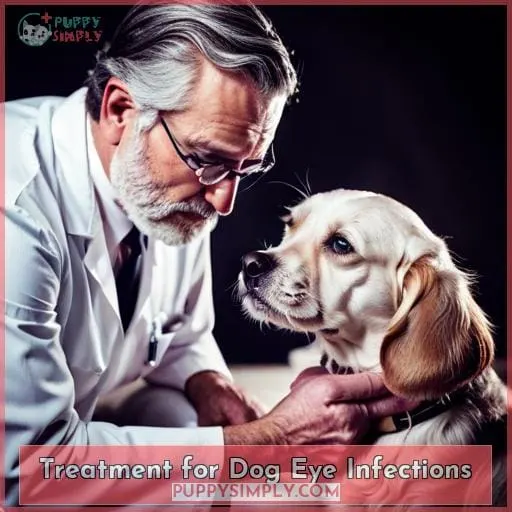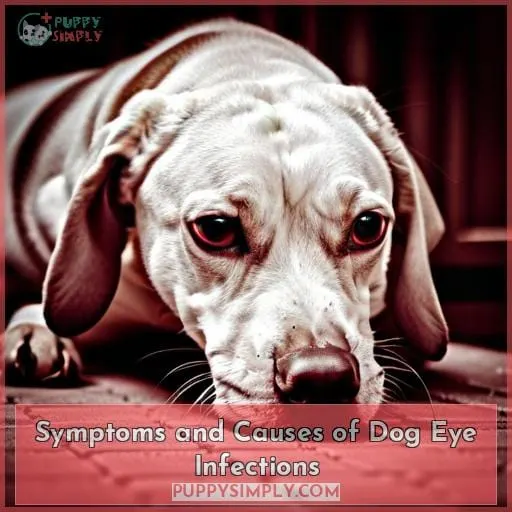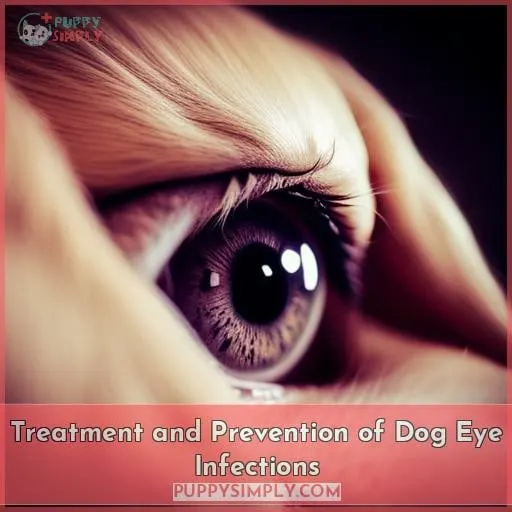This site is supported by our readers. We may earn a commission, at no cost to you, if you purchase through links.
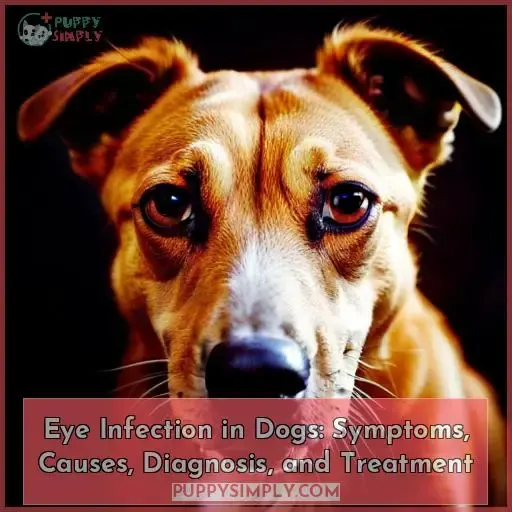 Eye infections are a common problem in dogs, affecting up to 20% of canines. There are many different types of eye infections, each with its own set of symptoms and treatments. In this article, we will discuss the most common types of eye infections in dogs, their symptoms, causes, diagnosis, and treatment.
Eye infections are a common problem in dogs, affecting up to 20% of canines. There are many different types of eye infections, each with its own set of symptoms and treatments. In this article, we will discuss the most common types of eye infections in dogs, their symptoms, causes, diagnosis, and treatment.
- Conjunctivitis
- Keratitis
- Glaucoma
- Uveitis
- Panophthalmitis
Table Of Contents
Key Takeaways
- Types of dog eye infections include eyelid and tear gland infections, conjunctivitis (also known as pink eye), uveitis, and cornea problems.
- Causes of dog eye infections include bacterial infections, viral infections, fungal infections, foreign bodies, irritants, injuries, and parasites.
- Symptoms of dog eye infections include pawing or itching at the eyes, eye discharge, pink or red appearance, swollen shut or mild swelling, excessive blinking, light sensitivity, and squinting.
- Treatment for dog eye infections includes antibiotics for bacterial infections, antifungal medications for fungal infections, addressing underlying causes (e.g., allergies), and severe trauma necessitates immediate veterinary care.
Types and Causes of Dog Eye Infections
Eyelid and tear gland infections can cause discomfort and eye discharge.
Conjunctivitis, also known as pink eye, is a common eye infection in dogs that results in a red/pink appearance and foul-smelling discharge.
Uveitis is a serious eye infection that causes red, swollen eyes that can be painful.
Infections in Eyelids and Tear Glands
With eyelid and tear gland infections, your dog may experience:
- Pawing at their eyes
- Eye discharge
- Redness
Conjunctivitis (pink Eye)
Having infections in eyelids and tear glands isn’t the only risk to your dog’s eye health. Conjunctivitis, also known as pink eye, is another common eye infection in dogs.
Uveitis
Uveitis is an eye infection that affects your dog’s uvea, the middle layer of the eye.
Causes:
- Viral, bacterial, fungal, or parasitic infections
- Immune-mediated conditions
- Trauma
- Eye surgery
Cornea Problems
Cornea problems, though less common, can lead to eye infections in dogs.
These include:
- Corneal abrasions
- Corneal ulcers
- Corneal neoplasia
Various Causes: Bacterial, Viral, Fungal Infections, Foreign Bodies, Irritants, Injuries, Parasites
When it comes to dog eye infections, various causes such as:
- Bacterial, viral, fungal infections
- Foreign bodies
- Irritants
- Injuries
- Even rare cases of parasites
can contribute to the development of these conditions.
It’s important to seek veterinary care for proper diagnosis and treatment.
Symptoms of Dog Eye Infections
Symptoms of Dog Eye Infections
- Pawing/itching at eyes
- Eye discharge
- Pink/red appearance
- Swollen shut or mild swelling
- Excessive blinking
- Light sensitivity
- Squint
Pawing/itching at Eyes
Pawing at or keeping your dog’s eye closed is a common symptom of eye infections.
- Discharge
- Redness
- Swelling
- Pain
- Squint
- Light sensitivity
- Protrusion of the third eyelid
Eye Discharge
After pawing at your dog’s eyes, you may notice a yellow-green discharge. Other types of discharge include:
- Purulent (thick, white)
- Clear (watery)
- Bloody (red)
- No discharge
Pink/red Appearance
If your dog’s eyes have a pink or red appearance, it may be indicative of an eye infection.
Swollen Shut or Mild Swelling
When your dog’s eyes are swollen shut or have mild swelling, it can be a clear indication of an eye infection.
Excessive Blinking, Light Sensitivity, Squinting
You may notice your dog excessively blinking, squinting, or showing light sensitivity as signs of an eye infection.
Diagnosing Dog Eye Infections
Diagnosing Dog Eye Infections
A veterinarian will conduct a physical examination and may order tests to diagnose an eye infection in your dog.
- A culture of the eye discharge
- An intraocular pressure test
- Eye dilation tests
Veterinarian Examination and Tests
Continuing from discussing the symptoms of dog eye infections, your veterinarian will conduct a thorough examination and perform specific tests to diagnose the underlying cause.
Bacterial Infections: Culture of Eye Discharge
Following a veterinarian examination, culturing your dog’s eye discharge can help diagnose bacterial infections. This will help determine the best course of treatment, which may include antibiotics, the sensitivity to which will be determined by the culture, and the length of treatment, which will depend on the severity of the infection.
Glaucoma Assessment: Intraocular Pressure Test
- To assess glaucoma, your veterinarian will conduct an intraocular pressure test, which measures the fluid pressure inside your dog’s eyes.
Normal IOP is 15-20 mmHg. Elevated IOP >25 mmHg indicates glaucoma. Elevated IOP is measured with a tonometer by applying pressure to the cornea.
Normal anterior chamber is deep and dark. Abnormal anterior chamber is shallow and light with a flat iris.
Eye Dilation Tests to Identify Abnormalities
In addition to a physical exam and eye discharge culture, your veterinarian may perform eye dilation tests to identify abnormalities in your dog’s eyes including:
- Conjunctivitis
- Tear production
- Ulceration
Treatment for Dog Eye Infections
Antibiotics are prescribed for bacterial infections.
Antifungal medications are used for treating fungal infections.
Addressing underlying causes (e.g., allergies) is essential for viral or secondary infections.
Severe trauma necessitates immediate veterinary care.
Advanced treatments are available for severe cases of eye infections in dogs.
Antibiotics for Bacterial Infections
To treat bacterial infections in dogs’ eyes, your veterinarian may prescribe antibiotics. These medications are effective and safe when used at the appropriate dosage and frequency. It’s important to follow your vet’s instructions to minimize side effects and risks.
If you have any concerns or questions about alternative treatment options, consult with your veterinarian for a professional consultation.
Antifungal Medications for Fungal Infections
After your dog’s bacterial infection is treated with antibiotics, you’ll need to give them antifungal medications to treat the fungal infection.
- Treatment Timeline:
- Side Effects:
- Resistance:
- Cost:
Addressing Underlying Causes
In addition to antibiotics, addressing the underlying cause of your dog’s eye infection is crucial to a full recovery, such as allergies, trauma, or dry eye.
Immediate Veterinary Care for Severe Trauma
Along with addressing underlying causes, severe trauma to the eye necessitates immediate veterinary care.
- Seek veterinary attention within 24 hours for corneal ulcers, discharge, or pain.
- Surgery may be required for foreign bodies, injuries, or glaucoma.
- Vision loss can be a serious complication of untreated eye trauma.
Advanced Treatments for Severe Cases
Advanced treatments are available for severe cases of eye infections in dogs. These include:
- Laser surgery
- Corneal ulcers
- Stem cells for corneal regeneration
- Amniotic membrane for corneal grafts
- Conjunctival flaps for corneal protection
Thermal therapies can also be used to treat uveitis.
Symptoms and Causes of Dog Eye Infections
Pawing at or keeping the eye closed, excessive tearing, and a yellow-green discharge are common symptoms of eye infections in dogs.
These infections can be caused by viruses, bacteria, or fungi, or by irritants such as shampoo or foreign matter.
To determine the cause of your dog’s eye infection, your veterinarian will perform a thorough eye exam and may take a sample of the discharge to culture.
Pawing/itching, Discharge, Redness, Swelling
Pawing, discharge, redness, and swelling are all symptoms of eye infections in dogs.
See your vet right away for diagnosis and treatment.
Infectious Causes: Viruses, Bacteria, Fungi
Infectious causes of eye infections in dogs include:
- Viruses:
- Distemper
- Adenovirus
- Herpes virus
- Bacteria:
- Brucella
- Leptospirosis
- Pseudomonas aeruginosa
- Fungi:
- Aspergillus
- Candida albicans
Take your dog to the vet for diagnosis and treatment.
Non-infectious Causes: Irritants, Foreign Matter
You can experience eye irritations if your dog’s eyes come into contact with foreign matter or irritants, such as pollen, dust, or dirt.
Shampoo, dirt, hair, smoke, and pollen may all contribute to eye infections.
Treatment and Prevention of Dog Eye Infections
Treatment for dog eye infections typically involves the use of:
- Antibiotics
- Anti-inflammatory drugs
- Antihistamines
In severe cases, surgical intervention may be necessary.
Regular eye exams, nutritional support, and environmental maintenance can help to prevent eye infections in dogs.
Medications: Antibiotics, Anti-inflammatory Drugs, Antihistamines
Antibiotics, anti-inflammatory drugs, and antihistamines are used to treat and prevent dog eye infections.
It’s important to consult with a veterinarian for the correct dosage and possible side effects of these medications.
Long-term use should be monitored for effectiveness while considering resistance and alternative treatment options.
Costs may vary, so checking insurance coverage is recommended before purchasing these prescription medications.
Surgical Interventions for Severe Cases
In addition to antibiotics and anti-inflammatory drugs, surgery can be used to treat severe cases of dog eye infections.
Surgical interventions such as eyelid reconstruction, corneal grafts, lens implants, entropion surgery, and strabismus correction are available options for addressing complex or advanced eye infections in dogs.
Regular Eye Exams, Nutritional Support, Environmental Maintenance
To maintain optimal eye health in your dog, regular eye exams, proper nutritional support, and environmental maintenance are essential.
- Schedule routine check-ups with a veterinarian to detect any potential issues early on.
- Ensure your dog’s diet includes nutrients that promote good eye health.
- Additionally, keep their environment clean and free from irritants that could cause infections.
Regular care will help prevent and treat dog eye infections effectively.
Frequently Asked Questions (FAQs)
How long does it take for an eye infection to go away in dogs?
How long does it take for an eye infection to go away in dogs?
It depends on the type of infection and the severity of symptoms.
Most eye infections in dogs can be treated with antibiotics or other medications, and symptoms should start to improve within a few days.
However, some infections may require more intensive treatment or surgery, and it may take longer for symptoms to fully resolve.
Can eye infections in dogs be contagious to humans?
Eye infections in dogs can be contagious to humans, particularly bacterial and fungal infections.
- Washing hands thoroughly
- Avoiding direct contact with the eyes or discharge
What are the signs of an eye infection in dogs?
Eye infections in dogs may manifest as:
- Excessive tearing
- Winking or blinking
- Prolapse of the third eyelid
- Yellow-green discharge
- Pawing at or keeping the eye closed.
Seek veterinary care promptly for diagnosis and treatment.
What are the most common causes of eye infections in dogs?
Eye infections in dogs are commonly caused by bacteria, viruses, or fungi.
Other triggers include foreign bodies, irritants, injuries, and parasites.
What are the best ways to prevent eye infections in dogs?
Want to keep your dog’s peepers healthy?
Trim bushes to avoid eye trauma.
Keep fur around eyes trimmed and clean.
Avoid head exposure in moving cars.
Conclusion
While eye infections are a common problem in dogs, they can be effectively treated with prompt veterinary care. By being aware of the symptoms and causes of eye infections, you can help your dog avoid serious complications.
Symptoms of eye infections in dogs can include:
- Redness, swelling, or discharge from the eyes
- Excessive blinking or squinting
- Pawing at the eyes
- Cloudiness or a film over the eyes
- Loss of vision

